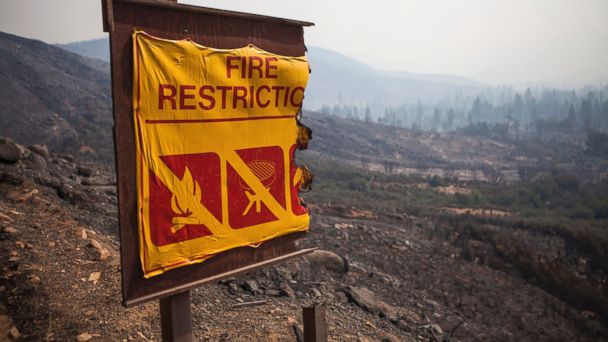Did Weird 2013 Weather Track With Global Warming?

: A fire restriction sign is partially burnt by the Rim Fire near Buck Meadows, Calif., Aug. 22, 2013. Max Whittaker/Reuters
The United States was hit with seven weather and climate catastrophes costing $1 billion or more in 2013, but caught a slight break in the overall number of tornadoes. Overall, it was a wet and warm year for much of the US, according to government records.
Last year 109 people were killed by severe storms, heat waves and tornadoes, according to the National Oceanic and Atmospheric Administration, or NOAA. Despite several damaging tornado outbreaks in 2013, last year actually had the fewest number of twisters-about 900-since 1989.
"There's several ingredients that have to come together for these large-scale events to happen and those ingredients didn't come together very often during 2013," said Jake Crouch, a climate scientist with NOAA's National Climatic Data Center. "We did have a cooler-than-average spring," Crouch said during a conference call with reporters. "That could be a factor in the below-average tornado activity."
Severe drought plagued the West in 2013, and continues into 2014. California recorded its driest year ever, with 7.38 inches of precipitation, more than 15 inches below average, NOAA said. Firefighters in the Golden State are now on high alert thanks to hot, windy weather.
"One of the important water supplies is mountain snowpack, and most mountain locations in California have less than 25 percent of average snowpack," Crouch said.
In contrast, 10 states in the Northern Plains, Midwest and Southeast had one of their 10-wettest years on record. Both Michigan and North Dakota had their wettest years ever recorded, NOAA said. As for temperature, NOAA scientists say 2013 was above average in the lower 48 states, tying with 1980 as the 37th-warmest year on record. Winter, summer and fall were all warmer than average, with spring coming in cooler than average, NOAA said.
Climate scientist Deke Arndt says overall, 2013 was a relatively "benign" year for weather extremes compared with previous years. But he says climate scientists are "very confident" about climate impacts that are already happening as humans continue warming the planet. The average temperature of 52.4 degrees Fahrenheit exceeded the previous century's average, the agency said.
"We expect to see more 'big heat', or stronger, more frequent and longer-lasting heat waves as the world gets warmer," said Arndt, who works as the chief of the climate monitoring branch at NOAA's National Climatic Data Center in Ashville, N.C.
"We expect to see more 'big rain' in the form of the biggest events getting bigger. We would expect to see fewer big cold events. And we are indeed seeing that in the data," he said.
These are 2013's billion-dollar disasters, as tallied by NOAA:
-Southeast severe weather (hail, tornadoes, wind) event on March 18 -Midwest / Plains severe weather (hail, tornadoes, wind) on April 7-11 -Midwest / Plains / East tornadoes on May 18-22 -Midwest / Plains / Northeast tornadoes on May 27-31 -Colorado floods on September 10-16 -Western drought / heatwave from March to September -Late-season Ohio Valley tornado outbreak on November 17.